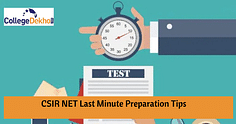
IIT JAM Biotechnology 2025 Exam will be an opportunity for you to apply to M.Sc. and Integrated PhD programs at top institutes like IIT Bombay, IISc Bangalore, and select NITs. IIT JAM Exam 2026 is a 3-hour computer-based test that evaluates your understanding across the core fundamentals of Biology. Core areas such as Molecular Biology, Genetics, Biochemistry, Cell Structure, and Enzymology are seen to dominate. This article features 10 expert-reviewed questions, shortlisted from previous year papers and 2025-targeted mock tests, reflecting frequently tested concepts in JAM BT Exam .
Question Selection Criteria & Topic Weightage
The questions in this article are drawn from IIT JAM Biotechnology papers (2015–2024), along with mock tests and topic-wise practice sets. IIT JAM Biotechnology Questions selection is based on questions that appear frequently and carry high marks, especially from units like Molecular Biology, Enzymology, and Biotechnology techniques.
The selection also considers recurring question formats across MCQ, MSQ, and NAT types. Insights from expert breakdowns on platforms like YouTube have been used to cross-verify concepts with the highest scoring potential.
Approximate Topic-Wise Weightage (based on previous trends):
- Molecular Biology: 18–20%
- Biotechnology Techniques: 15–17%
- Biochemistry & Enzymology: 14–16%
- Cell Biology: 10–12%
- Microbiology: 8–10%
- Genetics: 7–9%
- Plant & Animal Physiology: 6–8%
- Ecology & Evolution: 5–7%
- Biostatistics & Math: 5–6%
- Physics & Instrumentation: 4–5%
Top 10 JAM Biotechnology Questions with Expert Guidance
Question 1: What steps are taken for the Polymerase Chain Reaction (PCR)?
Expert Insight: This appears often in JAM BT under Molecular Biology/Techniques.
How to Solve: Know the three phases and their temperatures — denaturation (94–96°C), annealing (50–65°C), extension (72°C). Remember primers and the role of Taq polymerase.
Question 2: How do operons function in gene regulation?
Expert Insight: Consistently seen in MCQs about Lac and Trp operons.
How to Solve: Practice genetic control diagrams and feedback mechanisms. Understand promoter, operator, repressor, and inducer.
Question 3: Calculating initial velocity (v₀) in enzyme kinetics
Unit/Topic: Biochemistry, Enzyme Kinetics, Michaelis–Menten equation.
Expert tip/common mistake: Errors come from misplacing values or mixing units.
How to solve: Identify and substitute correctly.
Question 4: Determining Apparent ???????? in Competitive Inhibition
Expert tip/common mistake: In competitive inhibition , the Vmax remains unchanged, but the Km increases by a factor. A common mistake is forgetting that this factor must be multiplied by the original KmK_mKm, not added to it.
How to Solve: To determine the apparent KmK_mKm in competitive inhibition, identify the original KmK_mKm, the inhibitor concentration, and the inhibition constant from the question. Then, calculate how much the inhibitor increases the KmK_mKm by finding the fold-change due to inhibition, and multiply that with the original KmK_mKm to get the apparent value.
Question 5: What is the definition of Km in enzyme kinetics?
Unit/Topic: Biochemistry/Enzyme Kinetics (Definition)
Expert tip/common mistake: Where velocity is half of Vmax, the substrate concentration is denoted by Km. This is sometimes confused by students with "maximum velocity concentration. Direct concept recall; no calculation.
Example: 10 µM
Question 6: How is Vmax calculated when Km, [S], and v₀ are known?
Unit/Topic: Biochemistry/Enzyme Kinetics.
Expert tip/common mistake: To find the maximum reaction rate (Vmax), you need to rearrange the Michaelis-Menten equation. The new equation is: Vmax = (initial reaction rate * (Michaelis constant + substrate concentration)) / substrate concentration. i.e., Vmax = (v0 * (KM + [S])) / [S]. Using the given numbers: Vmax = (50 µM/min multiplied by (5 µM + 10 µM)) divided by 10 µM. This works out to Vmax being (50 multiplied by 15) divided by 10, which results in 75 µM/min.
Question 7: How do we figure out how much energy (ATP) cells get from glucose, and how well do they do it?
Unit/Topic: Biochemistry, Bioenergetics, Glycolysis, Stoichiometry.
Expert Tip: Convert theoretical ATP to actual ATP by applying an efficiency percentage (e.g., 75%). A common error is neglecting this factor.
Theoretical yield (per glucose) is ~32 ATP (or 38 ATP, older). With 75% efficiency, this becomes 24 ATP (32 x 0.75).
Question 8: What is the total ATP yield from glucose oxidation?
Unit/Topic: Biochemistry, Cellular Respiration, Bioenergetics.
Expert tip/common mistake: Recall NADH/FADH₂ yields correctly.
NADH: 2 (glycolysis) + 2 (pyruvate oxidation) + 6 (TCA) = 10 NADH.
FADH₂: 2 FADH₂.
ATP equivalents: ATP; ATP.
Total = 28 ATP.
Question 9: How is the standard free energy change (ΔG°′) calculated from the equilibrium constant (Keq)?
Unit/Topic: Biochemistry, Bioenergetics, Thermodynamics.
Expert tip/common mistake: Formula: ΔG∘=−RTlnKeq\Delta G^\circ = -RT \ln K_{eq}. Errors come from wrong R values or unit conversion.
Use R = 8.314 J/mol·K, T = 298 K.
Put in the given Keq.
Change the answer to kJ/mol.
Question 10: What are the steps and critical reagents in PCR?
Unit/Topic: Molecular Biology Techniques.
Expert Tip: PCR phases — denaturation (94–96°C), annealing (50–65°C), extension (72°C). Taq polymerase is essential.
Draw and label each phase, show primer binding and extension. Briefly compare regular PCR, RT‑PCR, and qPCR to show use-cases.
Expert Study Tips for JAM BT
- Qualifying the IIT JAM Biotechnology exam asks you to have a well-structured and strategic approach. Ensure to have a combination of comprehensive conceptual understanding with consistent, analytical practice. You can gain great marks in IIT Biotechnology if you have a strong understanding of Biology fundamentals alongside the ability to solve analytical problems across all four main subjects.
- You must keep your eyes on high-scored topics such as Molecular Techniques, Enzyme Kinetics, and Genetic Engineering.
- Grasp concepts and understand through chapter-wise PYQs and practice MCQs using reliable platforms or expert YouTube classes.
- Solving NATs regularly expands on your lab-based calculation abilities. Throughout preparation, have quick notes, flowcharts, or diagrams on hand for quick review and memory assistance.
- Give priority to high-weightage topics in Molecular Biology, Biochemistry, and Genetics, alongside foundational Chemistry, Mathematics, and Physics, for a good knowledge base.
- Practice Previous Year Questions and mock tests, together with proper error analysis, will give you the chance to improve your problem-solving skills and confidence.
- Pay attention to applying theoretical knowledge to practical scenarios and improve your score, and gain a strong base for advanced studies in biotechnology at IIT, IISCs or other crucial institutions.
| Top 10 IIT JAM Mathematics Questions Answered by Experts | Top 10 IIT JAM Physics Questions Answered by Experts | Top 10 IIT JAM Chemistry Questions Answered by Experts |
|---|
Visit CollegeDekho for more informative articles on competitive exams!
Are you feeling lost and unsure about what career path to take after completing 12th standard?
Say goodbye to confusion and hello to a bright future!

FAQs
Molecular Biology, Biochemistry, Genetics, and laboratory techniques make up over half of the paper.
Exact questions are very rarely repeated. However, questions from the same concepts and formats are often repeated.
JAM BT checks on your deeper conceptual understanding and application focused questions, GAT-B comparitivtely is relatively more factual and higher in volume.
Was this article helpful?





















Similar Articles
CSIR NET 2025 Last Minute Preparation Tips
Common Mistakes to Avoid in CSIR NET Preparation
CSIR NET 2025 Exam Day Instructions: Documents Required to Carry, Do's and Don'ts
CSIR NET Exam Centres: State-Wise List, Instructions
PSU Opportunities After Qualifying CSIR NET Exam
PSU Recruitment Process for CSIR NET-qualified Candidates